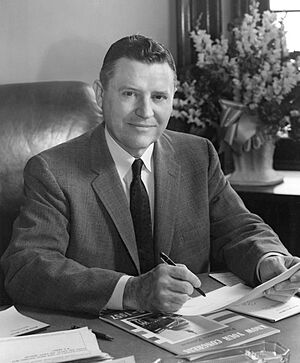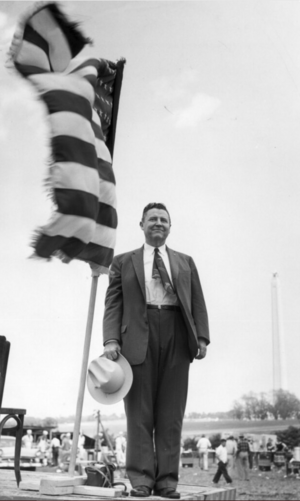Ralph Yarborough facts for kids
Quick facts for kids
Ralph Yarborough
|
|
|---|---|

Yarborough in 1957
|
|
| United States Senator from Texas |
|
| In office April 29, 1957 – January 3, 1971 |
|
| Preceded by | William A. Blakley |
| Succeeded by | Lloyd Bentsen |
| Personal details | |
| Born |
Ralph Webster Yarborough
June 8, 1903 Chandler, Texas, U.S. |
| Died | January 27, 1996 (aged 92) Austin, Texas, U.S. |
| Political party | Democratic |
| Spouse |
Opal Warren
(m. 1928) |
| Children | 1 |
| Education | Sam Houston State Teachers College University of Texas at Austin (LLB) |
| Military service | |
| Allegiance | |
| Branch/service | |
| Years of service | 1923–1926 (NG) 1943–1946 (Army) |
| Rank | Staff Sergeant (NG) Lieutenant colonel (Army) |
| Unit | 36th Infantry Division |
| Battles/wars | World War II |
Ralph Webster Yarborough (June 8, 1903 – January 27, 1996) was an American politician and lawyer from Texas. He was a Democrat who served in the United States Senate from 1957 to 1971. He was known as a leader of the progressive side of his party. This meant he supported social and economic improvements for all people.
Unlike many Southern politicians at the time, Yarborough did not support the 1956 Southern Manifesto. This document called for states to resist racial integration in schools and public places. Yarborough voted for important laws like the Civil Rights Act of 1964 and the Voting Rights Act of 1965. These laws helped ensure equal rights for all Americans. He was the only senator from a former Confederate state to vote for all major civil rights bills passed during that time.
Yarborough was born in Chandler, Texas. He became a lawyer after studying at the University of Texas School of Law. He worked to protect public funds from large oil companies. After serving in World War II, he ran for governor several times. He later won a special election to become a U.S. Senator in 1957. He was re-elected in 1958 and 1964, even defeating George H. W. Bush in 1964.
People often called him "Smilin' Ralph." His campaign slogan was "Let's put the jam on the lower shelf so the little people can reach it." This showed his goal to help everyday people. He strongly supported programs like Medicare (health care for seniors) and Medicaid (health care for low-income families). He also helped create the Endangered Species Act and worked to protect the Big Thicket National Preserve in Texas.
Contents
Early Life and Education
Ralph Yarborough was born in Chandler, Texas, in Henderson County. He was the seventh of nine children. He briefly attended the United States Military Academy at West Point. However, he decided to become a teacher instead. He studied at Sam Houston State Teachers College and then the University of Texas at Austin.
Yarborough earned his law degree from the University of Texas Law School in 1927. He worked as a lawyer in El Paso. In 1931, he became an assistant to the Texas Attorney General, James V. Allred. From 1923 to 1926, he served in the Texas Army National Guard. He reached the rank of Staff Sergeant.
Legal Career and Public Service
Yarborough was very skilled in Texas land law. He focused on cases against large oil companies. These companies sometimes broke rules about oil production or didn't pay royalties for drilling on public land. He became well-known for winning a huge case against Mid-Kansas Oil and Gas Company. This case brought in a million dollars for the state.
When James V. Allred became governor, he appointed Yarborough as a judge in Travis County. Yarborough was later elected to this position. During World War II, he served in the United States Army starting in 1943. He rose to the rank of lieutenant colonel. Before becoming a senator, he also taught land law at the University of Texas School of Law.
Political Journey
Running for Governor of Texas
Yarborough ran for governor of Texas several times in the 1950s. He challenged the more conservative (traditional) Democrats led by Governor Allan Shivers. Yarborough gained support from labor unions and people with more liberal views. He criticized Shivers for supporting Republican presidential candidates instead of Democrats.
The 1954 election was especially tough. Shivers used fears about racial integration to gain votes, as the Brown v. Board of Education decision had just happened. Even so, Yarborough almost won. In 1956, he made it to a runoff election against Price Daniel. Yarborough believed he actually won this election, but the official results showed Daniel ahead. Despite these losses, his campaigns made him very popular across Texas.
Becoming a U.S. Senator
In 1957, Senator Price Daniel resigned to become governor. Yarborough then ran in the special election to fill the empty Senate seat. Because no runoff was needed, he won with the most votes (38%). He joined fellow Texan Lyndon B. Johnson in the Senate.
As a senator, Yarborough was different from many other Southern senators. He supported national Democratic goals. These included more funding for health care, education, and protecting the environment. He also worked to expand the G.I. Bill, which provides benefits to veterans. His first big success was helping pass the National Defense Education Act of 1958. This law started federal funding for loans and grants to universities and students.
In 1958, Yarborough easily won the Democratic primary and the general election. During his first full term, he helped pass a bill to make Padre Island National Seashore a national park.
A Strong Disagreement in the Senate
In 1964, after the Civil Rights Act of 1964 passed, a debate happened in the Senate. Senator Strom Thurmond strongly opposed a new appointment to the Community Relations Service. This service was meant to help solve racial disputes. Thurmond tried to prevent a meeting from having enough senators present to vote.
Yarborough arrived and wanted to enter the meeting. He joked with Thurmond, "Come on in, Strom, and help us get a quorum." Thurmond replied that he would try to keep Yarborough out. Both senators were 61 years old. They had a brief, heated disagreement. Another senator suggested they stop. Eventually, the committee chairman broke up the argument. Both senators then entered the room, and the appointment was approved.
The Kennedy Assassination
On November 22, 1963, Ralph Yarborough was in the motorcade in Dallas when President John F. Kennedy was assassinated. He was in the car just two cars behind the President's limousine. In his car were Vice President Lyndon B. Johnson and Lady Bird Johnson.
Before the trip, Yarborough had some disagreements about the arrangements. President Kennedy himself asked Yarborough to ride with Johnson in Dallas. Yarborough later called the assassination "the most tragic event of my life."
Re-election and Later Career
In 1964, Yarborough won re-election to the Senate. His Republican opponent was George H. W. Bush. Bush criticized Yarborough for being too liberal and for supporting the Civil Rights Act of 1964. Yarborough argued that Bush was too extreme and a "carpetbagger" (someone from out of state trying to buy a seat). Yarborough won with 56.2% of the vote. In 1967, he introduced the first bilingual education act in the U.S. Senate.
While Yarborough supported President Johnson's domestic policies (things happening inside the U.S.), he disagreed with Johnson's foreign policy, especially the Vietnam War. After Johnson announced he wouldn't run again, Yarborough openly criticized the war. He supported Robert F. Kennedy for president in 1968.
Defeat and Retirement
In 1970, Yarborough lost his re-election bid in the Democratic primary to Lloyd Bentsen. Bentsen campaigned as a more conservative candidate. He criticized Yarborough's opposition to the Vietnam War.
Yarborough tried to win another Senate seat in 1972 but lost in the primary runoff. After 1972, he did not seek public office again. He continued to practice law in Austin until he passed away in 1996.
Death and Legacy
Ralph Yarborough died in 1996 at his home in Austin. He is buried at the Texas State Cemetery next to his wife, Opal Warren. The Texas State Cemetery is sometimes called "the Arlington of Texas."
Yarborough is remembered for helping to modernize Texas. He was a strong voice for liberal ideas in Texas politics. He pushed for oil companies to pay more taxes. Many people who worked with him later became important leaders, like Ann Richards, who became governor of Texas.
The University of Texas at Austin Press published a book about him called Ralph W. Yarborough: The People's Senator. The Yarborough Branch of the Austin Public Library is named in his honor.
Yarborough was very committed to science. He supported the creation of NASA in 1958. He believed NASA would help technology grow. He also pushed for more science and technology education in schools. He said, "NASA helped push ahead progress in technology. The country's schools should be oriented towards developing technology and teaching science."
See also
 In Spanish: Ralph Yarborough para niños
In Spanish: Ralph Yarborough para niños



